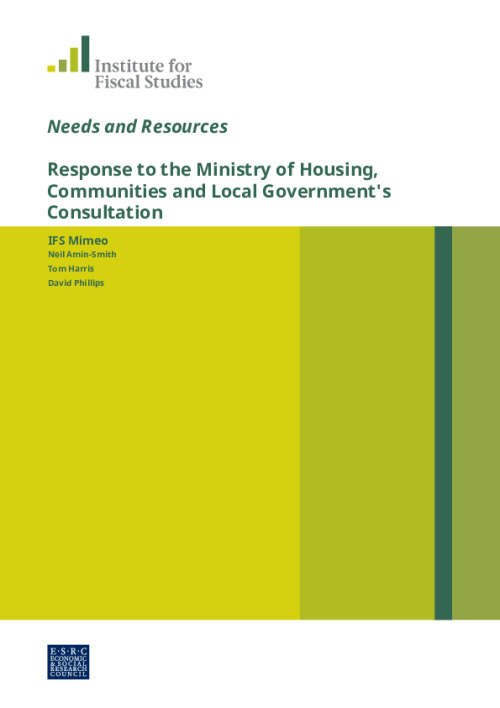This note is a response to the consultation from the Ministry of Housing, Communities and Local Government concerning the needs and resources of local authorities.
The key points made by this note are:
- The overarching approach for assessing spending needs seems sensible. It makes sense to consider the spending areas that are likely to have different drivers of spending needs separately. Separating out factors affecting need for service provision and those driving the costs per unit of provision (via the area cost adjustment) is also sensible. And making use of neighbourhood and individual level data for assessing the need for social care services spending is likely to result in substantially more robust spending needs formulas than if council-level data had been used to derive them. However it is important to note that any formula derived from analysis of spending and service usage will be affected by the level of funding available at the time the data was collected – and if overall funding levels were higher or lower, spending and service use patterns and needs may differ.
- The rationale for basing the Foundation Formula (for services such as waste collection, libraries, parks, housing, planning and central administration) on population only is weak: the statistical results cited by the MHCLG are not strong enough to support such a decision. In particular, the fact that population explains the vast majority of variation in spending and factors like deprivation explain very little is unsurprising: population varies so much between councils (e.g. less than 40,000 in Rutland to more than 1.5 million in Kent) that it is inevitable that it will drive nearly all differences in overall spending levels. This would be true even if factors like deprivation are highly significant drivers of variation in spending need per person. The government should seek expert advice as to whether factors beyond population – such as deprivation – are in fact likely to be drivers of needs for such services, and use this alongside more appropriate statistical analysis in its decision making.
- A population-only Foundation Formula would lead to lower assessments of needs – and hence lower funding – for deprived (often inner city) councils than both the current formula and an updated formula that included deprivation. It would lead to higher assessments of needs – and higher funding – for less deprived (often suburban and rural) councils. However, the impact of the Fair Funding Review as a whole on different councils is still uncertain as we do not know the impact of other changes (such as reforms to social services formulas, transition, etc.) which will also matter greatly.
- The consultation is right that when taking account of ability to raise council tax revenues it is important to do this on the basis of a common notional tax rate and set of tax rules – rather than each council’s actual rate and rules. This is to ensure fairness between areas setting higher or lower tax rates, and to avoid perverse incentives to cut tax rates in the knowledge that reductions in revenues will be compensated for by extra grants (or higher top-ups or lower tariffs).
- The data to do this for most policies is readily available from councils’ Council Tax Base statistics - although deciding the exact notional tax rate and rules to use may be tricky. However, council tax support for working age families is a much more difficult case as up-to-date data to do this accurately is not readily available. This means either a costly data collection exercise; relying on data from 2012-13 when a common council tax support scheme was applied across the whole country; or use of a statistical proxy instead.
- The consultation suggests taking into account projected population growth when assessing councils’ spending needs in future years, but not taking it into account when assessing how their capacity to raise revenues via council tax may change over time. This is inconsistent unless the aim is to reward and incentivise population growth and housing development, on top of the incentives provided by the New Homes Bonus. If this is the case, the government should be explicit about this.
- An issue not raised in the consultation is whether to use fixed weights or changing weights for different service blocks when projecting forward overall spending needs. This matters because one might expect the need for different service areas to be growing more or less quickly over time due to demographic or socio-economic changes. Adult social care needs may be expected to rise rapidly because of an ageing population for instance, whereas this may not be the case for all other service areas.










